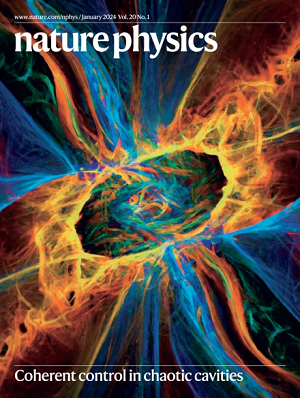新出现的肌动蛋白流解释了滑行运动的不同模式
IF 17.6
1区 物理与天体物理
Q1 PHYSICS, MULTIDISCIPLINARY
引用次数: 0
摘要
在宿主感染期间,弓形虫和相关的单细胞寄生虫利用滑翔运动进行移动,这与其他已知的真核细胞运动机制有着本质区别。滑行被认为是由夹在质膜和肌球蛋白覆盖的内膜复合体之间的一层薄薄的流动丝状(F)肌动蛋白驱动的。这种表面肌动蛋白层如何驱动实验中观察到的各种滑行模式--螺旋、环形、旋转和贴片、钟摆或滚动--尚不清楚。在这里,我们认为 F-肌动蛋白流是通过自组织产生的,并建立了一个在弓形虫几何形状限制下出现的 F-肌动蛋白流的连续模型。在存在 F-肌动蛋白周转的情况下,我们的模型预测会出现一种稳态模式,在这种模式中,肌动蛋白的运输主要向后方进行。去除 F-肌动蛋白周转会导致肌动蛋白斑块在细胞内上下循环,我们在实验中观察到了活的弓形虫寄生虫中药物稳定的肌动蛋白束。这些不同的自组织肌动蛋白状态可以解释观察到的滑行模式,说明了不同形式的滑行运动是如何作为 F-肌动蛋白在受限几何形状中流动的自组织特性的内在结果而出现的。本文章由计算机程序翻译,如有差异,请以英文原文为准。


Emergent actin flows explain distinct modes of gliding motility
During host infection, Toxoplasma gondii and related unicellular parasites move using gliding, which differs fundamentally from other known mechanisms of eukaryotic cell motility. Gliding is thought to be powered by a thin layer of flowing filamentous (F)-actin sandwiched between the plasma membrane and a myosin-covered inner membrane complex. How this surface actin layer drives the various gliding modes observed in experiments—helical, circular, twirling and patch, pendulum or rolling—is unclear. Here we suggest that F-actin flows arise through self-organization and develop a continuum model of emergent F-actin flow within the confines provided by Toxoplasma geometry. In the presence of F-actin turnover, our model predicts the emergence of a steady-state mode in which actin transport is largely directed rearward. Removing F-actin turnover leads to actin patches that recirculate up and down the cell, which we observe experimentally for drug-stabilized actin bundles in live Toxoplasma gondii parasites. These distinct self-organized actin states can account for observed gliding modes, illustrating how different forms of gliding motility can emerge as an intrinsic consequence of the self-organizing properties of F-actin flow in a confined geometry. Unicellular parasites, such as Toxoplasma gondii, can use different forms of gliding motions when infecting a host. These motility modes arise from the self-organizing properties of filamentous actin flow at the surface of these parasitic cells.
求助全文
通过发布文献求助,成功后即可免费获取论文全文。
去求助
来源期刊

Nature Physics
物理-物理:综合
CiteScore
30.40
自引率
2.00%
发文量
349
审稿时长
4-8 weeks
期刊介绍:
Nature Physics is dedicated to publishing top-tier original research in physics with a fair and rigorous review process. It provides high visibility and access to a broad readership, maintaining high standards in copy editing and production, ensuring rapid publication, and maintaining independence from academic societies and other vested interests.
The journal presents two main research paper formats: Letters and Articles. Alongside primary research, Nature Physics serves as a central source for valuable information within the physics community through Review Articles, News & Views, Research Highlights covering crucial developments across the physics literature, Commentaries, Book Reviews, and Correspondence.
 求助内容:
求助内容: 应助结果提醒方式:
应助结果提醒方式:


